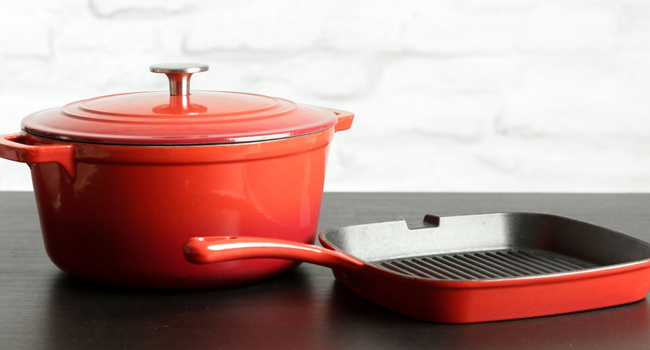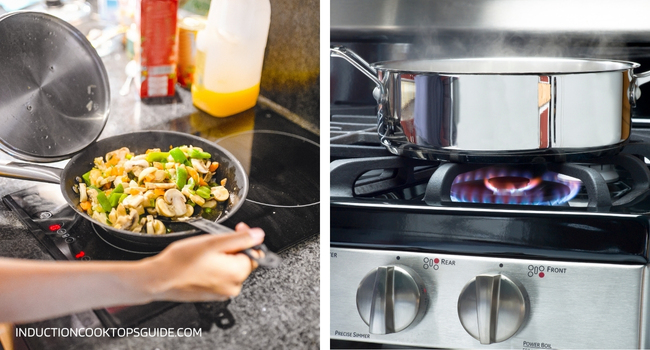You have probably heard about all the hype surrounding the newest groundbreaking technology in cooking ranges: induction cooktops.
But of course, not everything is perfect. Even this almost-perfect cooktop comes with its flaws.
In this article, we will tell you the benefits and drawbacks of owning and using induction cooktops.
What are the disadvantages of an induction stove?

Here is a list of all the drawbacks that come with owning an induction stove:
1. Expensive
If switching from gas or electric to induction stoves, be prepared to cash out no less than a thousand bucks.
The latest induction cooktops and range models are much more expensive than their electric or gas counterparts. The cheapest induction range costs over $1000, while an electric range with the same capacity will only cost around $700.
More than the unit itself, the installation will also demand hundreds of dollars more than an electric cooktop or gas burner unless you get a portable single or double-burner cooktop. In that case, you just plug it into the wall outlet.
2. Distracting Sound
When operating on higher than normal settings, induction cooktops might release a buzzing or humming sound.
The issue of buzzing sounds might be distracting to some. Luckily, the sounds that induction cooktops give off vary based on brand and model. Some are quieter, while some are louder.
Others compare it to the sound of an air conditioning unit, while others compare it to the sound you hear while inside the plane during take-off.
These sounds are due to the electromagnetic energy transmitted to your ferromagnetic cookware. The electromagnetic energy excites the cookware’s iron molecules and makes it heat up.
If this issue is a big deal to you, then you might consider trying the induction cookers at the store before buying. Often, there are sample models in store that you can test.
3. Maintenance
Aside from the cost of the unit itself, you would also have to consider its maintenance costs if you want your induction cooktop to last you long.
Induction smooth tops are relatively easier to clean. But you would have to be extra careful with the touch screen buttons as some models are sensitive to liquids.
Also, there are special cleaning creams to help clean grease or spilled food on your cooktop because scrubbing would scratch the cooktop surface.
Other than that, cleaning an induction smooth top is easy and intuitive.

However, expect that spare parts for induction cooktops are also expensive when they need to be repaired or replaced.
To save money, you might opt to buy generic spare parts instead. In this case, make sure you buy your cooktop from household brands since the spare parts are frequently replicated in the market.
If you bought your cooktop from a rare brand, you might have a hard time finding third-party spare parts. But you can also have it repaired at the store’s repair center, which might be pretty expensive if your repair is way past the warranty.
4. Electromagnetic Interference
As mentioned earlier, induction cookers depend on electromagnetism to heat up your cookware.
The induction cooktop’s magnetic field may interfere with other kitchen devices like digital thermometers. In this case, you may need an analog thermometer since it will not be affected by the presence of a magnetic field.
You might be asking: Isn’t exposure to electromagnetism unhealthy? In another section of this article, we will discuss how induction cooking affects our health.
Do induction cooktops break easily?
Induction cooktops are so powerful, but their build and design are so sleek that it looks fragile.
Earlier, we also discussed how repair and maintenance are a disadvantage. So we ask: Are induction cooktops durable?
Just like any other electronic device, induction cooktops also have a lifespan.
Consumer-grade induction cooktops are expected to operate for 10 000 hours, while commercial-grade induction cooktops can operate for up to 30 000 hours.
But, if you’re not careful, your induction cooktop will not last as long as expected.
The surface of induction cooktops is made of durable glass and ceramic. Improper handling of cookware can break or scratch the glass.
Using induction cooktops also means using induction-compatible cookware, which is usually made of heavy iron.

Be careful not to drag your cookware across the surface because heavy scratches may mess with the magnetic field of the cooktop.
Also, do not apply anything cold when the cooktop surface is still hot, as the sudden shift in temperature may break the glass.
Avoid placing objects that can melt — like plastics or aluminum — near the cooktop surface because they will be difficult to remove once it melts.
Obviously, do not drop heavy objects on the cooktop surface. Ensure that the surroundings of your cooktop do not have anything that could accidentally fall on it.
Is induction cooking harmful to health?
Going back to the issue of exposure to electromagnetism, let us now discuss whether induction cooking and the electromagnetic field it creates could actually affect our health.
We have to understand that electromagnetic fields exist everywhere all the time. We have it in our cellphones, and we double the exposure when we use our phones while charging.
Microwave ovens also have electromagnetic fields. So do digital thermometers, electrical alarm clocks, televisions, radios, WiFi routers, and even hair dryers.
The sun also emits electromagnetic waves, which we are constantly exposed to, and this is much more harmful than the electromagnetic field that a consumer-grade induction cooktop could ever create.
So, if you are not worried about these gadgets, electronic devices, and natural phenomena, then you don’t have to worry about using an induction cooktop.
Since induction cooktops require induction-friendly cookware like cast iron, another question about induction cooking is the alleged health benefits of using cast iron cookware.
Cooking using cast iron can indeed transfer iron minerals to the food that eventually goes to the body. However, the amount of iron actually absorbed into the body is not enough to significantly change our body’s iron supply.
So, it is not true that cooking with cast iron cookware can help with people’s anemia. Cooking with cast iron neither harms nor benefits our health.
Benefits of induction cooking
Earlier, we talked about the disadvantages of owning an induction stove. In this section, we will talk about the benefits of cooking with an induction stove.
1. Safety.
Induction cooktops boast their no-flame and no-heat feature.

Unlike gas stove tops (which produce flame) and electric cooktops (which have hot electric coils), induction cooktops rely purely on electromagnetism.
As a result, the cooktop only heats the iron cookware and not its surroundings.
Since there are no flames and hot areas aside from the cookware itself, there are lesser chances for the cooktop to catch fire and cause burns.
Thanks to electromagnetism, the cooktop will only function in the presence of magnetic cookware.
This means that even if you forget to turn off the cooktop, it will not heat up if there is no magnetic cookware on its surface.
This is helpful when you have children, the elderly, and pets at home.
2. Fast and precise.
Induction cooktops cook food 50% faster than gas stoves and electric cooktops. This is because all the generated heat goes directly to the cookware, unlike its gas and electric counterparts, which allow heat to escape to the air.
Moreover, induction cooktops allow for precise temperature controls. It changes the temperature as soon as you tap its buttons. You can bring your soup from a rolling boil to a simmer in just a few seconds.
3. Improved air quality.
Since heat does not escape from an induction cooker, the kitchen will remain cool.
Moreover, unlike gas burners which emit gas into the air, induction cookers keep the air safe and non-polluted. This is safer for people with asthma and other air quality-related health problems.
Disadvantages of induction cooking
Of course, induction cooking does not come without disadvantages which we will discuss in the next section.
1. Steep learning curve.
Shifting from gas or electric to induction is not an easy feat. It will take a lot of getting used to.
Switching to induction entails a change in your cooking habits and techniques.
For example, gas or electric users often chop onions and garlic while waiting for the oil to heat up. But with induction cookers, there is little to no waiting time.
You have to prep everything before turning on your induction cooker as you would not have to wait long for the oil to heat up or for the soup to boil.
Another thing you have to look out for is the habit of lifting the pan while cooking. You cannot do this with an induction cooker because doing so will break the electromagnetic field and, consequently, turn off the induction cooktop.
2. Only works on induction-compatible cookware.
As mentioned several times in this article, induction cooktops require special cookware.
How do you know you are using the right cookware? Simply do the magnet test. If a magnet sticks to it, that cookware is good to go.
Also, remember that your cookware has to have a flat bottom. Otherwise, it will not heat evenly, or worse, the electromagnetic field might not detect it.
Nowadays, most cookware has a looped coil symbol, indicating that it is compatible with induction cooking.
Some report that induction cooktops are not good for charring, toasting, or searing. However, that is the fault of the cookware, not the cooktop. Cast iron cookware is great for searing. Other iron cookwares are not as good.
Is an induction cooktop worth it?
At the end of the day, whether an induction cooktop is worth it or not ultimately depends on you.
If you value energy efficiency, fast cooking time, and improved air quality in the kitchen, and if you do not mind spending more dollars and adjusting your cooking habits, upgrading to an induction cooktop will certainly be worth it.
However, suppose you do not cook often or live alone or with a small family. In that case, the extra benefits of an induction cooktop might not compensate for the additional expenses it requires.
Even if induction cooktops offer all these appealing benefits, they are not for every kitchen and every cook.
Some users claim that induction cooktops gave them the best cooking experience they have ever had, yet they had to give it up because they could not afford the maintenance.
If you think you cannot maintain the future costs of owning an induction cooktop, you might as well just stick to gas burners or electric cooktops.
Or you may also opt to buy a portable induction cooktop with a single cooking space as they are much cheaper than those with more cooking spaces.
At the end of the day, what matters is that your new cooktop caters to your preferences and your kitchen needs.
Choose wisely.
When upgrading your cooking range, the ultimate deciding factor should be the net positive impacts that your new cooktop may offer.
If you think its pros and cons cancel each other out, then maybe consider buying something else!

Leave a Reply